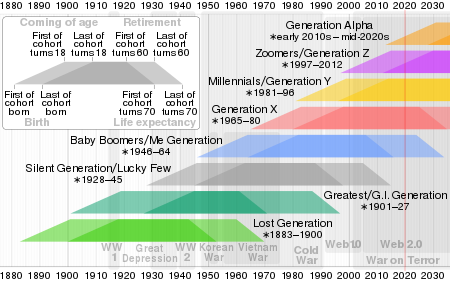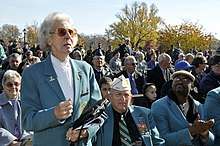Greatest Generation
The Greatest Generation, also known as the G.I. Generation and the World War II generation, is the demographic cohort following the Lost Generation and preceding the Silent Generation. The generation is generally defined as people born from 1901 to 1927.[1] They were shaped by the Great Depression and were the primary participants in World War II.
| Part of a series on |
| Major generations of the Western world |
|---|
 Timeline of major demographic cohorts since the late-nineteenth century with approximate dates and ages |
Terminology

The term The Greatest Generation was popularized by the title of a 1998 book by American journalist Tom Brokaw. In the book, Brokaw profiled American members of this generation who came of age during the Great Depression and went on to fight in World War II, as well as those who contributed to the war effort on the home front. Brokaw wrote that these men and women fought not for fame or recognition, but because it was the "right thing to do."[2] This cohort is also referred to as the World War II generation.[3]
Authors William Strauss and Neil Howe called this generation the G.I. Generation in their 1991 book Generations: The History of America's Future[4] The initials G.I. refer to American soldiers in World War II.
Date and age range definitions
Pew Research Center defines this cohort as being born from 1901 to 1927.[5] Strauss and Howe use the birth years 1901–1924.[6]
General discussion
This generation experienced much of their youth during rapid technological innovation (radio, telephone) amidst growing levels of worldwide income inequality[7][8][9] and a soaring economy.[10][11][12] After the Stock Market crashed, this generation experienced profound economic and social turmoil, and eventually World War II.
While Tom Brokaw and others extol this generation for supporting and fighting World War II, American historian and sociologist Harvey J. Kaye writes that in addition to ending isolationism, most Americans of the Greatest Generation wanted "to curb the power of capital, create economic growth and development, end poverty, and 'enable people to advance themselves.'"[13]
Characteristics
Research professor of sociology Glen Holl Elder, Jr., a prominent figure in the development of life course theory, wrote Children of the Great Depression (1974), "the first longitudinal study of a Great Depression cohort." Elder followed 167 individuals born in California between 1920 and 1921 and "traced the impact of Depression and wartime experiences from the early years to middle age. Most of these 'children of the Great Depression' fared unusually well in their adult years".[14][15] They came out of the hardships of the Great Depression "with an ability to know how to survive and make do and solve problems.”[16]
See also
References
- "Is It Time to 'Pass the Torch?' The Generational Dilemma of the 2020 Democratic Primary". 2019-07-30. Retrieved 22 December 2019.
- Brokaw, Tom (1998). The greatest generation - Tom Brokaw - Google Boeken. ISBN 9780375502026. Retrieved 2013-12-16.
- Rose, Kenneth D. (2008). Myth and the Greatest Generation. Taylor & Francis Group, LLC. doi:10.4324/9780203941461. ISBN 978-0-415-95677-2.
- Strauss, William; Howe, Neil (1991). Generations: The History of America's Future, 1584 to 2069. Harper Perennial. ISBN 9780688119126.
- "Americans Name the 10 Most Significant Historic Events of Their Lifetimes". People Press. 15 December 2016.
- Howe, Neil (30 July 2014). "The G.I. Generation and the "Triumph of the Squares"". Forbes. Retrieved 26 November 2016.
- "Striking it Richer" (PDF). eml.berkeley.edu.
- "U.S. income inequality, on rise for decades, is now highest since 1928". 5 December 2013.
- "5 facts about economic inequality". 7 January 2014.
- Granados, José A. Tapia; Roux, Ana V. Diez (13 October 2009). "Life and death during the Great Depression". Proceedings of the National Academy of Sciences. 106 (41): 17290–17295. Bibcode:2009PNAS..10617290T. doi:10.1073/pnas.0904491106. PMC 2765209. PMID 19805076.
- "Economy in The 1920s". www.shmoop.com.
- George H. Soule, Prosperity Decade: From War to Depression: 1917–1929 (1947)
- Kaye, Harvey J. (Apr 8, 2014). The Fight for the Four Freedoms: What Made FDR and the Greatest Generation Truly Great. New York: Simon and Schuster. pp. 148–149.
- "About Glen H. Elder, Jr". University of North Carolina at Chapel Hill. Retrieved 25 March 2019.
- "Lives in Changing Times". University of North Carolina at Chapel Hill. Retrieved 25 March 2019.
- Zernike, Kate (13 March 2009). "Generation OMG". The New York Times. Retrieved 25 March 2019.